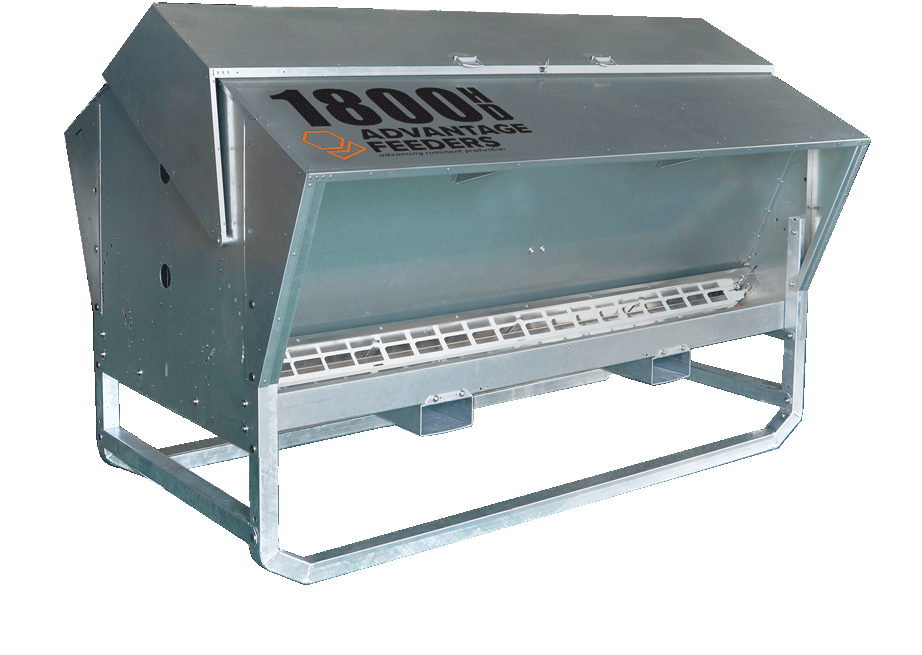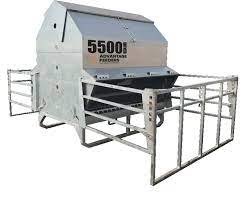Advantage Feeders (formerly 3 in 1 Feeders)
Advancing Ruminant Production
By facilitating controlled feeding (set feeder to deliver specific kg/head/day) producers can save significantly on labour and feed costs while improving pasture utilisation, improving feed conversion and improving rumen health.
Use as a controlled feeder, creep feeder or ad-lib feeder to suit your system in all seasons.
How do Advantage Feeders work?
-Advantage Feeders work by making livestock ‘lick’ the feed from an adjustable feed slot.
-Using a unique 3-way adjustment, the feed slot can be set to a specific width and depth to control the amount of feed received each lick.
-The adjuster guard above the feed slot prevents animals from ‘bulldozing’ feed into the lower feed tray.
-After around 10 minutes of licking an animal will run out of saliva and leave the feeder, only returning once sufficient saliva has been built up to recommence feeding.
-Fully opening both upper and lower adjuster and removing the adjuster guards allow the feeder to be used as an ad-lib feeder.
Watch this video to learn more: How our 3-Way Adjustment System Works
Features of the HD Range of Feeders
One Feeder - Multiple Applications, Year Round Use
Advantage Feeders can be used for different stock in many applications.
-Use the same feeder for cattle, sheep or goats
-Use as a controlled feeder, creep feeder or ab-lib feeder
For example use a 3800HD Feeder:
-Jan-Feb: Set to control intakes to supplement ewes before lambing (Jan-Feb)
-Mar-June: Creep lambs either ad-lib or controlled intake using the creep panels
-July-Aug: Introduce cattle at pasture to hard feed using controlled intake
-Sept-Dec: Bring feeder inside with cattle, increase intake gradually to finish on ad-lib
For even greater flexibility our range of mobile feeders can be used to aid rotational grazing or to haul full to outlying pastures.
Little and Often Feeding - The Benefits
Compared with traditional feeding methods where livestock are given supplementary feed once or twice a day, an Advantage Feeder set to control feed intake will result in livestock taking a little feed more often to receive their daily amount. This helps maintain a more stable rumen allowing for better conversion, better pasture utilisation and improved profitablity.
Reduce Feed Costs
With once a day feeding, the negative impact on the rumen reduces the effectiveness of the bacteria which break down forage. This means the animal is able to utilise the pasture/forage less. As a result more supplementary hard feed can be required which exacerbates the problem. Trials have show that 33% less supplementary feed can be required when fed little and often as opposed to once a day feeding.
By limiting daily intakes and keeping the rumen stable it is easier to feed high starch rations such as barley without acidosis/bloat. With complete ration ‘safe’ feeds from mills at £300+/ton a significant saving can be made by using feeds such as barley (£160/ton ex farm) with a protein balancer where required resulting in a ration at under £200/ton
Increase Stocking Density while Improving Performance
Supplementary feeding helps to balance the rumen with starch type energy sources reducing the amount of pasture/forage needing to be fed.
Immature pastures, early in the growing season, contain a high amount of water making them highly soluble. These breakdown rapidly in the rumen and can pass through undigested. By supplementing small amounts of high energy feeds through an Advantage Feeder we can increase the microbial activity of the gut while slowing the rumen throughput. This allows more pasture to be utilised and less wasted.
With high protein in some grasses, especially new leys with clover, the excess protein must be excreted through urine. This uses energy which could otherwise be used for growth. By supplementing the diet with through an Advantage Feeder we can add carbohydrate and fibre to balance ration and increase growth rates.
Creep Feeding Benefits
There are many benefits to creep feeding calves and lambs, including:
Providing an additional feed source (especially important with multiples, when pasture quality/availability is low, or dams BCS is low)
Aiding rumen development
Increasing DLWG
With Advantage Feeders it is possible to creep calves (using creep gates) or lambs (using creep panel). Studies have shown that
Creep Feeding and Controlling Intake
Trail data shows that lambs should be fed ab-lib creep until 2 weeks old, and calves until 4 weeks old. After which savings can be made by limiting intakes.
Studies show that optimal growth levels are achieved at 200kg.day for lambs and 1kg/day for calves, after this there is only marginal benefit in rumen development and pasture digestion. Additional feed over and above this will result in only a small additional weight gain for the cost. With an Advantage Feeder it is possible to control the intake to these levels once the initial ad-lib period is over.
Rumen walls of 6 week old calves on varying diets
Reduce Labour and Improve Farm Safety
Feeding once or twice a day increases labour costs. With an Advantage Feeder you can still feed a desired amount per head per day but with hopper sizes up to 5500 litres and optional attachments for filling directly from a blower wagon you can reduce the time spent feeding stock significantly.
Feeding can be dangerous with many farm accidents occurring when animals are being trough fed. With an Advantage Feeder, daily feed can be supplied, either housed or at pasture, without the need to carry bags through hungry livestock.
Reduce Feed Waste
Any feed that that animal drops or knocks from the feed slot lands in the stainless steel tray beneath. This is easily consumed.
Keeping the feed slot clean will help ensure the feeder empties evenly reducing the likelihood of stale feed.















